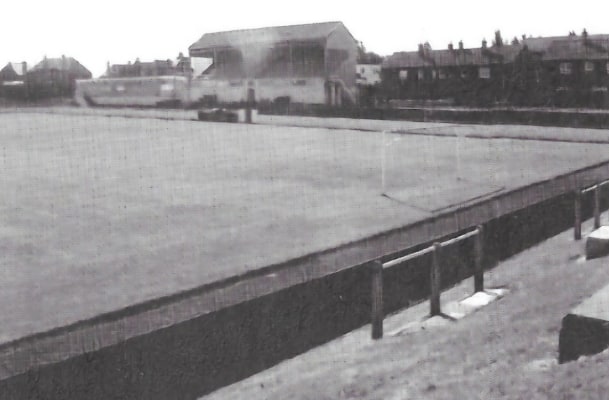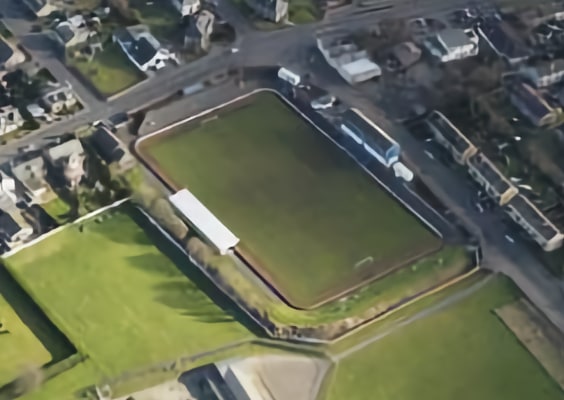History
How It All Began (1)
From the late 1870’s there were a number of areas used as football pitches in Bo’ness, Gray’s Park which is said to have overlooked Craigmailen Church, a ground to south-west of the town on an area which later became a church, it is thought the Old Kirk, a ground located somewhere in the area of Maidenpark called the Soo and Cra Park, all before the establishment of Newtown Park.
A Brief History of Newtown Park
It is believed that Newtown Park was created in 1885 by the miners living in the adjacent miners’ cottages on an area which is believed to have previously housed a colliery with various outbuildings. The turf was brought by the miners from the Bathgate Hills and laid to form the pitch. The ground contained a very small grandstand on the south side adjacent to a tramway or railway line which ran along a similar route to the current Jamieson Avenue. It would appear that the ground was first used in 1886.
In 1902 a new enlarged Grand Stand was built, which was originally proposed to be on the north side but it is unclear if this is where it was actually sited, turnstiles were installed and toilets and a refreshment stand.
When in 1921 Bo’ness FC purchased Newtown Park, the new owners of the park set about a programme of extensive refurbishment and improvement of the park and facilities. Over a few years a new structure was built, effectively the current pavilion which had a grandstand with a 500 capacity, a central press-box and four new turnstiles, also just prior to these works additional terracing to the north, south and west had been constructed.
After Bo’ness FC went into liquidation and ceased to exist as a senior club in 1933, Newtown Park was in the hands of the liquidators. Between 1938 and 1941 funds were raised through public subscription and agreement was reached in 1943 that a Trust made up of the Provost and Senior Baillie of the Burgh of Bo’ness, the Chairman and Managing Director of Bo’ness Co-operative Society and the Chairman of West Lothian District Council for the area of Kinneil and Carriden, took over responsibility of the park. A further piece of ground was acquired from Hamilton and Kinneil Estates in 1947.
During the Second World War years the park was hired by the Navy as a recreational base for HMS Stopford who were based at Bo’ness Harbour.

After a new club was formed in 1945 through the joining together of Bo’ness FC and Bo’ness Cadora, the Trustees rented Newtown Park to the new club Bo’ness United.
The Trustees through a Park Committee continued to maintain Newtown Park, and also made substantial improvements which included, an improved playing surface, concrete terracing and boundary wall to Jamieson Avenue and public toilets.
However in the late 1960’s and early 1970’s all the funds were exhausted and the Park Committee were finding that they were finding it more and more difficult to continue maintaining Newtown Park and action to resolve this situation was needed.
This arrangement was in place until 1975 when the responsibilities for Newtown Park were formally transferred by the Trustees to Bo’ness Town Council in agreement with Falkirk District Council which in the local authority re-organisation was taking over Bo’ness Town Council.
For a period of time Falkirk District Council lived up to this agreement and not only maintained the playing surface free of charge they carried out extensive works to the pavilion in the late 1970’s. However regrettably the arrangement seemed to fall into abeyance in the 1980’s/ early 1990’s, which resulted in the responsibility falling upon Bo’ness United who were required to fund all the maintenance and repairs, in order to keep the facility suitable for professional football.
The football club found the financial burden of the maintenance and repairs very difficult to sustain and in 2004 tried unsuccessfully to have Falkirk Council fulfil the terms of the previous agreement. However Falkirk Council did undertake an extensive review to establish the possible options of either updating Newtown Park or moving the facility as a whole to an alternative location. A basic refurbishment, exclusive of fitting out, was estimated at around £250K, a full refurb including a Community stand was estimated at around £1.6 million, the possibility of moving to a new location appeared unlikely, as using comparable costs of recently completed facilities elsewhere, the cost varied between £2.5 million and £7 million dependent of site and specification.
With Falkirk Council not willing to provide any assistance and the burden falling upon the football club it was decided by Bo’nessians in 2012 to form a Trust to take over the responsibility and in 2015 after long, protracted and costly negotiations, Falkirk Council finally agreed to the park being taken over by the Newtown Park Association for the benefit of the Bo’ness Community.

The Newtown Park Association successfully won a competition for funds made available by Falkirk Council to part fund the installation of an artificial 3g surface and floodlighting which amounted to (£370K). To progress these works the Newtown Park Association then embarked on a process to gain funding from Sportscotland in the amount (£250K). On successful completion of these negotiations and negotiating additional funding of (£30K) the project began in April 2019 and completed in late September 2019.
Newtown Park is now home to Bo’ness United Community Football Club and two senior semi-professional teams Bo'ness United and Bo'ness Athletic.
In an effort to help improve facilities for the Bo’ness Community, the Newtown Park Association has embarked on the process to provide a new Community Hub at Newtown Park. Extensive research has been completed to establish the needs of the Community, the findings were then passed to a design team who have completed a design for the building. The next, and most difficult step, is to seek out funding to progress the project. It is hoped that, with maximum co-operation and assistance from local and national governments and grant funding institutions, a new Community Facility will be in place in the foreseeable future.
(1) This information has been extracted from various sources, however there is no guarantee of the accuracy of the information or of the dates quoted.